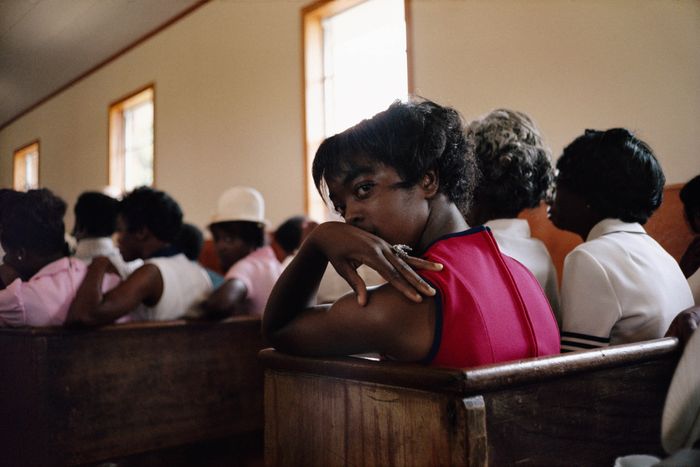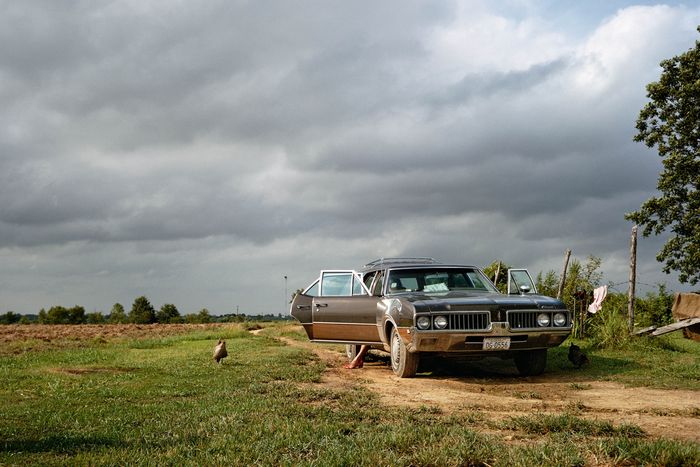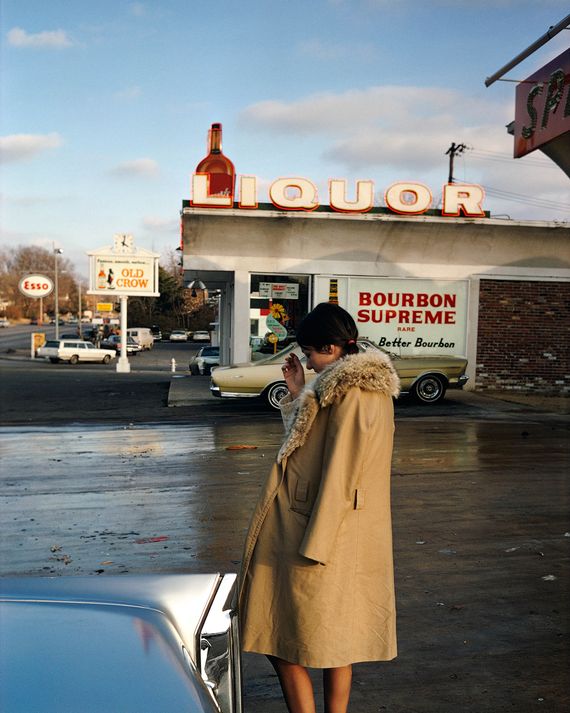
This article was featured in One Great Story, New York’s reading recommendation newsletter. Sign up here to get it nightly.
The last gallery exhibition I saw in 2022 stunned me. “The Outlands” is a series of large color photographs of the American South made by William Eggleston between 1970 and 1973, when he was in his 30s. The title comes from a family name on a metal sign outside a suburban Memphis home featured in one of the pictures. But it could almost be a name for the United States, both then and today.
The 29 pictures that were on view at David Zwirner, before the show closed in December, had never been seen before, culled by Eggleston and his sons from a collection of 5,000 images that he had filed away. Here were people, open fields, highways stretching into the distance; stores, gas stations, main streets; cemeteries, Black churches, Cadillacs. “The Outlands” is an odyssey of driving and stopping, waiting and looking.
Eggleston, 83, has been famous for almost a half-century. His path hasn’t been easy. His 1976 Museum of Modern Art show was dismissed by the New York Times as “boring” and “banal” and “snapshot chic,” “the most hated show of the year.” Eggleston was born rich in Memphis. I saw him when I gave a lecture there in the 1990s. As I started speaking, a couple danced in front of the stage and crashed into the band pit. A local peered down and said, “Hello, Bill.” Eggleston and his wife, Rosa, got up and walked away. No one batted an eye. The impression terrified me. I saw a city forced to make peace with this madman seer. He has been described as smelling “like bourbon and body lotion.”
Critics clinging to the idea that photography should be black and white — in other words, that the photos not look like they came from a point-and-shoot camera — supposed Eggleston was bringing high art down with popular culture. In fact, he brought high art into popular culture and changed both. His supersaturated colors intensify and distort the usual expectations of color photography. There’s nothing pastoral or sentimental about these pictures, which he calls his “little paintings.” Once when sitting with his hero, Henri Cartier-Bresson, the Frenchman opined that “color is bullshit.” Eggleston got up and “went to another table.” He says he’s “at war with the obvious.”
The diffused light, feathery visual edges, low horizons, receding space, and non-narrative details make Eggleston’s photographs like 16th- and 17th-century Dutch landscape paintings. And like those meticulously depicted works, Eggleston’s pictures go beyond subject matter and take on an allegorical weight. There’s a lot of humanity in these images. The late Peter Schjeldahl called him a “blues photographer.”
The cover of the catalogue pictures a two-tone Oldsmobile station wagon with Tennessee plates parked on a dirt road. Three of its doors are open. A rag on a nearby barbed-wire fence flutters. As two chickens look on, the ruby-red slipper-shoe of a woman (Rosa) steps out the door. There’s a witchy imperiousness to this shoe on earth. Storm clouds fill the sky. Rural America, telephone poles, a pack of Camel cigarettes on the dashboard — a couple stopping for a rest (or in rut). This is the road trip, time on your hands, getting away, a big American car, but also the weather is coming in, a dream of Oz and the deluge in one image.
The scenery Eggleston depicts isn’t backdrop. It’s alive. As a former long-distance truck driver who has seen a half-million miles of scenery, I came to view passing postcard landscapes as a series of repeated deaths. Driving was seeing without thinking, looking as a mindless present. Passive, a kind of narcotic. Eggleston’s “scenery” clutches you in its talons. Spirits seem to fill the air of this America.
And unspoken segregation. The people in these photos look askance at one another. Anyone walking into one of Eggleston’s pictures would be sized up, shunned, or accepted, according to elaborate codes of body language, clothing, race, gender, and age. “The Outlands” is ethnographic this way, pictures of socio-political and religious tribes. Every group is almost a closed society. His space is one of suspicion, surveillance, paranoia. Norms and mores are silently enforced. See the many signs saying “No:” No parking, no smoking, no loitering. You don’t cross lines here.
We see moral decay brought on by racism, corruption, resentment. Masochism and viciousness, insidious demons, tyrannical forces that make people unwilling to change. For decades we have told ourselves that these forces were dying. What makes “The Outlands” so extraordinary is that it shows that none of that died. We also told ourselves that this was a disease of the South. In fact, the disease was everywhere.
Eggleston makes you see that all space is social space, political space. Nothing is neutral. A picture of a country post office shows an American flag blowing in the breeze. It looks like summer. The Zip Code is 39110, placing it just north of Jackson, Mississippi. An “I Want You” Uncle Sam recruiting poster is in the window. When these pictures were being made, Richard Nixon knew the Vietnam War was lost. Delaying the end of the war, he campaigned on “peace with honor.” It was all a lie. As divided as the country is now between red and blue, the country was then between pro- and anti-war, mainstream and counterculture. “The Outlands” gives us an America where looking at someone the wrong way or being in the wrong place at the wrong time can set off sparks. A place where the guilty still walk free. A place we all know now.
One picture is of an overgrown tree along a puddly, potholed dirt road. There’s a cardboard poster on it that reads “Hutchinson for Sheriff.” Another image gives us a boarded-up building with a sign that reads “Elect Skillman Prosecuting Attorney.” Both posters include photos of the candidate to let voters know that each is white. A sign on a station wagon says “Register Communists Not Our Firearms.” There are warnings everywhere. Look at the bullet holes in truck windows and on signs. In a picture of men knee-deep in muddy water outside a gas station, you can almost hear Bob Dylan singing “High water rising.”
Eggleston’s pictures are clairvoyant. We see the same psychic affliction, internal perditions, segregation, and heartlessness, everyone on their own, each for their own group, against the world. We see people seething with impotent rigidity. This soul leprosy makes “The Outlands” an eyewitness account of a country that somehow survived its own death, that is already in the antechamber of its own afterlife.



